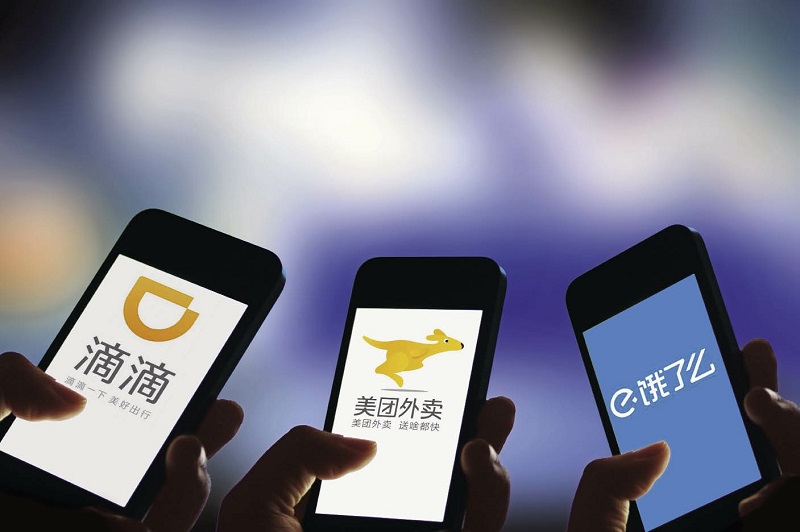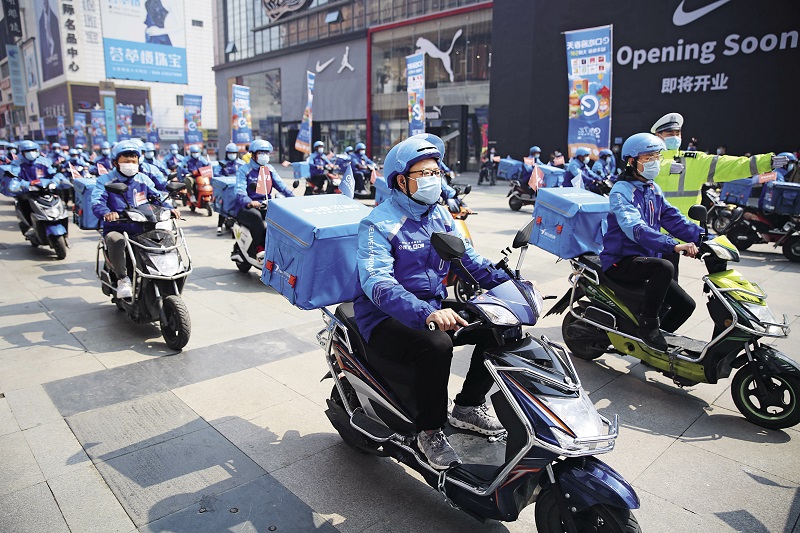
Smart phone apps have become a daily necessity for Chinese urbanites. Data show that by the end of 2019, half of the 900 million Internet users in China had ordered takeouts through Meituan takeout, Ele.me, and other takeout apps.
It's cold and you don’t want to eat outside, or maybe you hate to stand in long queues at a restaurant waiting to be seated. The solution to your discomfort couldn’t be easier. Pick up your smartphone and order a takeout meal.
Whether you’re craving for a cup of steaming coffee or a slice of creamy cake, food delivery apps can order a rapid delivery scooter to zip over to your door within 30 minutes.
Thanks to the development of the Internet, artificial intelligence, big data, and other technologies, food delivery services have become deeply integrated into the daily lives of Chinese people, enabling them to enjoy all kinds of conveniences by just a few taps on a phone screen.
Convenient Way of Life
Bai Lin, a white-collar worker in the financial sector in Beijing’s CBD, is so immersed in work every day that it is a luxury for him to go to a nearby restaurant for a sit-down lunch. So for Bai, ordering a takeout meal is a lifesaver. Every day at noon, he orders his favorite dishes on food delivery apps, which arrive warm by 12:30. For Bai this is an essential time saver.
In China, the number of people ordering takeout food has been increasing year-by-year owing to its convenience. According to iResearch, by the end of 2019, of the 900 million Internet users in China, there were about 460 million ordering takeouts, up 12.7 percent year-on-year. The size of China’s catering takeout service industry reached RMB 653.6 billion in 2019, up 39.3 percent from 2018.
The spread of takeout services in China has accelerated after the COVID-19 outbreak. During the pandemic, hankering after popular restaurants’ signature dishes, Wang Fang in Xicheng District, Beijing, chose to order online and eat at home. Wang is one of millions who changed their dining out habits because of safety considerations.
During the third quarter of 2020, Meituan, a catering giant, saw its takeout transaction volume reach RMB 152.2 billion, a year-on-year growth of 36 percent. The number of daily takeout transactions on average was 34.9 million, up 30.1 percent year-on-year. The number of users also reached a new high this quarter.
Wang always clicks the “no contact delivery” button in her takeout order. In this way, the delivery person only needs to leave the food at the place designated by her, avoiding any direct human contact, which minimizes the risk of contracting the virus. “The attached card also bears the name of the delivery person and their temperature that day. In addition, there are a few antiseptic wipes included with the delivery, which makes me feel safe,” said Wang.
The convenience of food delivery services is also reflected in the details. Now, food delivery platforms have launched set meals for one person, promoting small and half portions to both lower the price and avoid food wastage. “I no longer have to worry about wasting food and I can also order more signature dishes now,” said Du Xingyu, who lives alone.
Nowadays, not only meals, but also fruits, vegetables, flowers, medicine, and even daily necessities can all be bought on takeout apps. Consumption demands are therefore being satisfied across a range of goods.
Channeling Customers to

The Chinese northeastern city of Shenyang cooperates with Alibaba’s lifestyle app Koubei in launching a campaign named “Renewal of Urban Life” on April 18, 2020. During the campaign, many delivery scooters paraded through the streets to encourage the recovery of the local catering sector.
Offline Restaurants
For the majority of catering businesses, delivery platforms help them expand new sources of income effectively.
Yunhaiyao, a restaurant of south Yunnan ethnic cuisine with over 100 stores across China, set up their takeout apps in 2018. Since then, its Ganjiakou restaurant in Beijing alone handles over 2,000 takeaways each month. Pei Xiaohui, the manager, said, “Our Ganjiakou restaurant has cooperated with many delivery platforms, and the takeout business accounts for one-third of our total revenue. During the pandemic, that proportion even reached 50 percent.”
Ordering takeout food online has also channeled more customers to offline restaurants. Pei said that 70 percent of his customers choose to eat in their physical restaurant.
“I got to know Yunhaiyao from the delivery platform, but when I went to the brick-and-mortar restaurant, I liked its dining environment and service better [than the takeout delivery]. I can eat the freshly cooked hot dishes right away, and better communicate with my friends face to face,” said Wu Xiaolong, a diner at Yunhaiyao.
“Now we are also able to get direct feedback from customers through their online reviews. It not only helps us to improve our dishes and services, but also helps us to estimate how much food we should prepare so as to reduce waste,” said Pei.
The food and beverage industry was hit hard during the pandemic, while the takeout industry took the opportunity to flourish. 2020 Q3 Enterprise Development Big Data Report by qcc.com shows that during the first quarter of 2020, 8,023 new registrations related to takeout catering were recorded, with year-on-year growth of 120.8 percent; 26,800 in the second quarter, up 311.9 percent year-on-year; 49,000 in the third quarter, up 514.8 percent year-on-year. At present, there are 118,000 takeout catering businesses in China, of which the self-employed account for 71.6 percent.
Information Technology Drives Development
Although the takeout business may seem labor-intensive, it’s actually more technology-intensive. Its development relies on artificial intelligence, big data, cloud computing, Internet of Things, and other high tech.
How to provide users with the best service experience is always the first thing to think about. Formerly, takeout orders were distributed to delivery staff by restaurants through the platform, but now, with technological innovations, a smart system within the platform will do the job.
The sector’s three titans, Meituan takeout, Ele.me, and Baidu takeout, have all developed their own order distribution systems. The systems automatically analyze the data of each order and plan the fastest route for delivery staff. In times of heavy rain or snow, they will also allocate more time to ensure safe delivery. Ele.me’s smart order distribution system covers over 2,000 cities and counties throughout the country, with the average delivery time being shortened to 28 minutes per single order.
In addition to its smart order distribution system, Meituan takeaway has also launched a new intelligent equipment system with intelligent electric vehicles, intelligent safety helmets, smart food boxes, voice assistants, and indoor positioning base stations. These five new devices empower delivery staff to be more efficient after they log into their version of the Meituan app. It’s estimated that during the whole food delivery process, from food preparation to delivery, nearly 80 percent of phone operations are simplified and the speed of receiving orders has increased by 50 percent.
In addition, with help of big data technology, takeout platforms are able to create virtual portraits of their diners, which includes dish preferences, prices, services, etc. Such information is very useful for catering businesses to develop accurate marketing strategies and send tailor-made notices, as a way of improving user experience.
Self-driving has also become another major direction. As early as 2016, Meituan has been exploring robot-aided delivery. Wang Xing, founder and CEO of Meituan, said, “We have completed multiple R&D iterations in the field of unmanned vehicles and drones, and have applied for more than 60 technology patents.” In his view, the core of the booming takeout economy lies in technology-driven productivity.